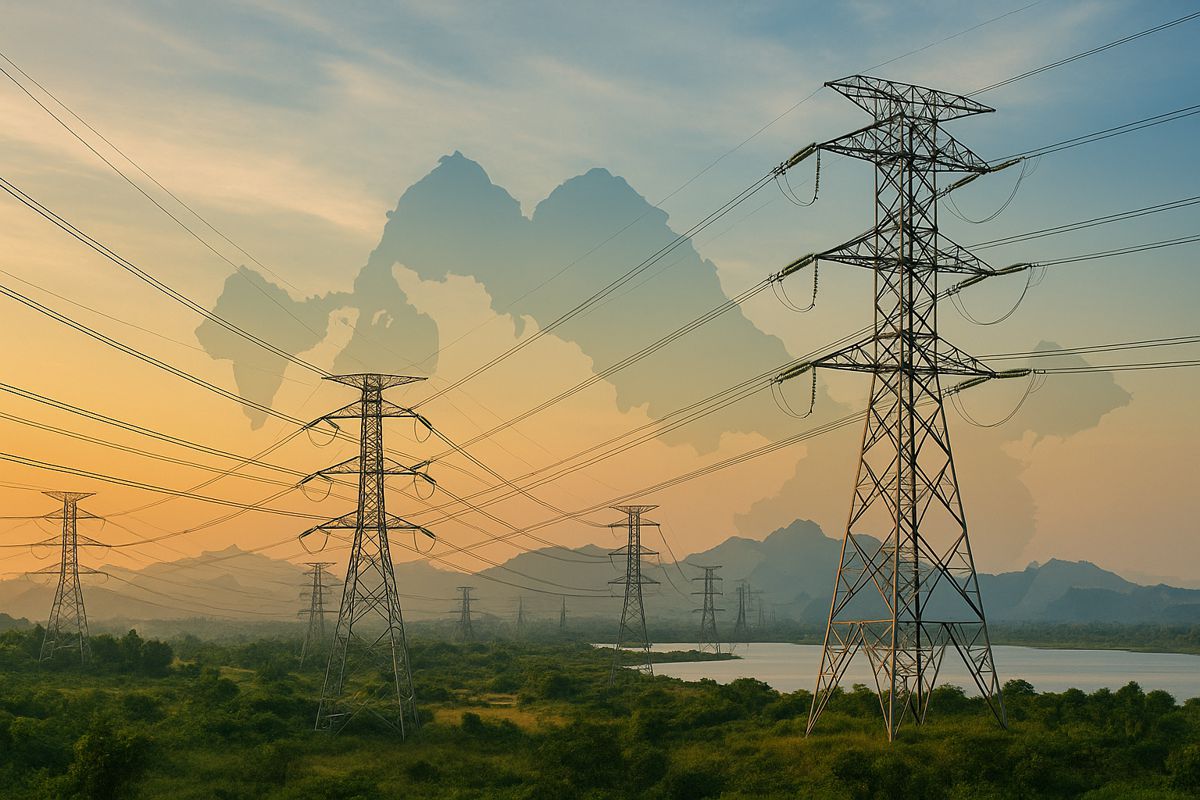ASEAN Power Grid Financing Initiative Transforming Southeast Asia’s Energy Landscape
The Asian Development Bank (ADB), the World Bank Group, and the Association of Southeast Asian Nations (ASEAN) have unveiled a landmark financing initiative designed to bring the ASEAN Power Grid (APG) to life.
With backing from the ASEAN Secretariat and the ASEAN Centre for Energy (ACE), this effort represents one of the most ambitious regional energy collaborations ever undertaken, aiming to connect Southeast Asia’s electricity networks and build a sustainable energy future by 2045.
The launch of the ASEAN Power Grid Financing Initiative (APGF) marks a defining step towards achieving energy security, affordability, and regional cooperation. At the 42nd ASEAN Ministers on Energy Meeting (AMEM), energy leaders reaffirmed that the APG should extend beyond cross-border connectors to include domestic grid upgrades and subsea power cables essential for linking archipelagic nations.
The Scale of Investment and Opportunity
The ASEAN Interconnection Masterplan Study (AIMS) III, developed by the Heads of ASEAN Power Utilities/Authorities (HAPUA) and ACE, estimates a staggering US$764 billion investment requirement to build the transmission infrastructure and power generation capacity necessary to accommodate higher shares of renewable energy.
ASEAN’s Secretary-General, Dr. Kao Kim Hourn, highlighted the significance of this effort: “The benefits of the ASEAN Power Grid are clear: more affordable and reliable electricity for people and communities, stronger regional resilience, and greater opportunities for shared and inclusive growth. A fully connected ASEAN Power Grid by 2045 is not just about power exchange, it is about enhancing regional competitiveness and improving the quality of life across our region.”
Dr. Kao also emphasised the urgency of action: “Strong partnerships are already in place; what is needed now is a new generation of financing solutions, well designed and implemented with urgency.”
Scaling Up Cross-Border Power Connections
Currently, ASEAN’s cross-border interconnection capacity stands at around 7.7 gigawatts. To meet future regional energy demands, this figure must more than double by 2040. The Executive Director of the ASEAN Centre for Energy (ACE), Dato’ Ir. Ts. Razib Dawood, stressed the importance of collaboration: “ASEAN’s current 7.7 GW of cross-border interconnections capacity will need to be more than doubled by 2040 to allow for more energy cooperation supporting regional growth and welfare. ACE welcomes the initiative from the Asian Development Bank and the World Bank to support us in the financing journey of the ASEAN Power Grid.”
He added that ACE, as Secretariat of the APG Financing Working Group alongside the ASEAN Secretariat and the two multilateral banks, is “committed to advancing the APG initiative for the energy future of our region.”
Mobilising Finance for Regional Transformation
The ASEAN Power Grid Financing Initiative (APGF) will be jointly led by ADB and the World Bank Group, working closely with ACE and the ASEAN Secretariat to mobilise large-scale project financing for cross-border power interconnections across land and sea.
To achieve this, both banks will deploy a broad suite of financial instruments, including grants, concessional and regular loans, guarantees, and political risk coverage. Advisory services on public–private partnerships (PPP) and equity investment will also form part of the financing mix. Importantly, ADB and the World Bank will not only finance directly from their own balance sheets but also leverage private capital and partnerships with commercial lenders and donors.
ADB has pledged up to US$10 billion for the initiative over the next decade, supported by an initial US$6 million in technical assistance funded by ADB, the United Kingdom, the European Union, and other partners. Meanwhile, the World Bank is contributing an initial US$2.5 billion under its Accelerating Sustainable Energy Transition Program (ASET), which includes a US$12.7 million seed grant to ACE to prepare bankable projects and define the next phase of APG support.
Partnership for ASEAN Connectivity on Energy
One of the key components of the initiative is the establishment of the Partnership for ASEAN Connectivity on Energy (PACE), a platform created to strengthen collaboration among international financial institutions, donors, commercial banks, and philanthropies under the APGF umbrella. PACE aims to streamline coordination, accelerate project preparation, and ensure financing flows efficiently into critical energy interconnections.
ADB Vice-President for East and Southeast Asia and the Pacific, Scott Morris, described the opportunity: “The ASEAN Power Grid presents an extraordinary opportunity to meet Southeast Asia’s growing energy needs. We’re committed to building a coalition of governments, utilities, investors, and innovators, united by a shared commitment to regional energy integration, to deliver lasting benefits for generations to come.”
Economic Growth and Sustainability Benefits
A fully interconnected grid across Southeast Asia promises far-reaching benefits. By enabling cross-border power trading, the APG will enhance energy security, reliability, and resilience while driving down electricity costs through economies of scale. For businesses, this means more predictable energy prices and increased competitiveness across sectors.
The initiative is also expected to unlock significant renewable energy potential, particularly from solar, wind, and hydro resources distributed unevenly across the region. Interconnected grids allow countries with surplus renewable capacity to export energy, helping neighbouring nations decarbonise and diversify their energy mix.
Regional integration is expected to create thousands of skilled jobs and stimulate industrial growth, particularly in grid manufacturing, engineering, and clean technology sectors. These developments will, in turn, attract foreign investment and enhance Southeast Asia’s standing in the global green energy transition.
Policy Harmonisation and Long-Term Vision
However, realising a fully integrated ASEAN Power Grid by 2045 will require more than money. The path forward demands unprecedented regional cooperation, harmonised regulations, and shared governance structures.
To make regional power trading a reality, ASEAN nations must align energy policies, standardise technical protocols, and create market mechanisms that facilitate transparent and efficient electricity trade. Political will, long-term commitment, and policy consistency will be essential in turning this 30-year vision into a functioning energy network.
World Bank Vice-President for East Asia and the Pacific, Carlos Felipe Jaramillo, reaffirmed the Bank’s dedication to ASEAN’s energy transition: “We at the World Bank are committed to supporting ASEAN countries in funding and implementing an energy mix that works best for them. Their initiative to scale up renewables is key to generating more affordable and reliable power, boosting competitiveness and creating jobs.” He added: “We are deeply committed to supporting the ASEAN countries in realising the vision of the ASEAN Power Grid backed by technical assistance and the full choice of financing instruments of the World Bank Group.”
Renewed Political Commitment
While the concept of a regional power grid dates back to the 1990s, recent momentum signals that this time, implementation may finally match ambition. The upcoming signing of the APG Enhanced Memorandum of Understanding this year underscores ASEAN Member States’ renewed commitment to making the grid a cornerstone of regional energy policy.
The APGF’s launch signifies more than just infrastructure funding, it represents a regional pact for sustainable growth and shared prosperity. Through strategic collaboration, innovation, and visionary leadership, ASEAN and its partners are setting the stage for an energy transformation that could define the next century.
Powering a Connected Future
As Southeast Asia continues its rapid economic expansion, energy demand will only rise. The ASEAN Power Grid Financing Initiative demonstrates how collective action, supported by world-class financial and technical institutions, can bridge the energy divide and empower communities across borders.
By blending political will, technical expertise, and innovative financing, the ASEAN Power Grid is poised to become a model of sustainable energy cooperation. The initiative embodies a shared belief, that a connected, resilient, and low-carbon energy network is within reach, lighting the way toward a more prosperous and sustainable future for all.




















